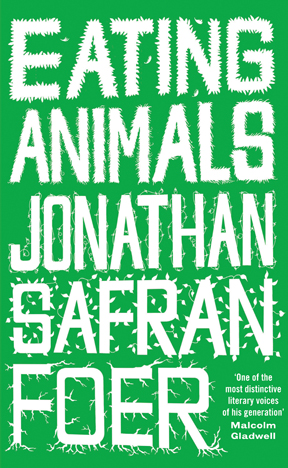The ugly truth about eating animals
By Hannah Weiner
The Guardsman

“Eating Animals” is Jonathan Safran Foer’s exploration of what people are eating in regards to meat. Soon to be a new father, the author’s curiosity about omnivore versus vegetarian lifestyles became an urgent need for understanding. So Foer sets off to answer his own questions, which consequently leads him to late night visits to factory farms, questions about fundamental arguments regarding the morality of eating animals, and discoveries of the true meanings of misleading terms used in the meat industry like “free-range” and “all-natural.”
Foer states at the beginning of the book that he is not making an argument for vegetarianism. As comforting as that sounds there seems to be constant pressure throughout the book to change one’s eating habits. Foer doesn’t come right out and say, “don’t eat meat,” but he conveys a subtler message: It’s okay if you do it, but I could never bring myself to do it. I don’t really understand how you do it, but don’t worry, I’m not judging you.
The gruesome facts do speak for themselves. The truth about how animals are treated while alive as well as how they are killed is horrifying. Foer goes into great detail about the living conditions of chickens, turkeys, cows and pigs kept on factory farms.
After making several unanswered requests to visit different factory farms, Foer sneaks onto one farm in the middle of the night and finds that some of “the ends of the beaks of the chicks are blackened,” some chicks are “blood matted,” and some are “covered in sores.”
At some farms dead animals are held in the same confinement areas as the live ones, easily spreading bacteria, and animals are tortured. There is a long list of inhumane acts being committed at these farms. “Eating Animals” definitely provides information that everyone needs to know.
One problem with “Eating Animals” is the redundancy of the content. Foer uses many pages to essentially rephrase the same point, which only results in the feeling that he is beating his point to death. His arguments would be stronger if they did not seem so overbearing.
One has to give Foer credit, though, he did his research. The arguments he makes are difficult, if not seemingly impossible, to counter. The vast majority of the content reads like investigative reporting and he backs up his positions with valid information. The details about factory farming listed in the novel were confirmed by numerous sources. The notes in the book take up 61 pages.
While thorough, “Eating Animals” is not all facts and statistics. Foer talks about the culture and relationships that are a part of eating and shares his own personal stories with the reader, some of which are funny, some of which are sad. If he is anything, Jonathan Safran Foer is a good storyteller.

Comments are closed.